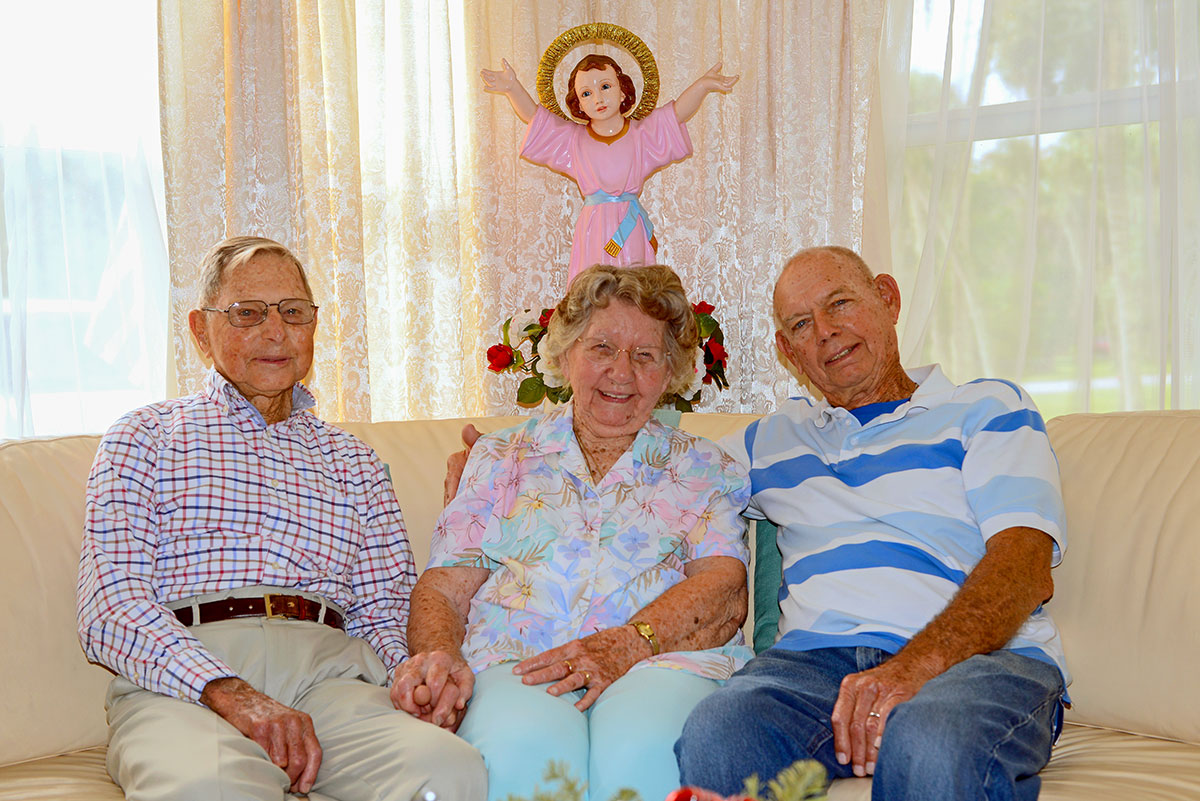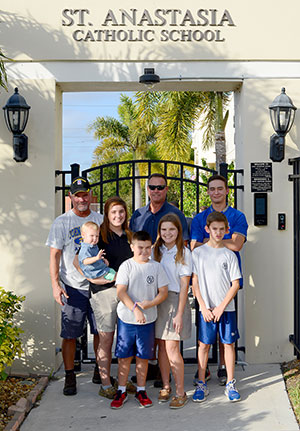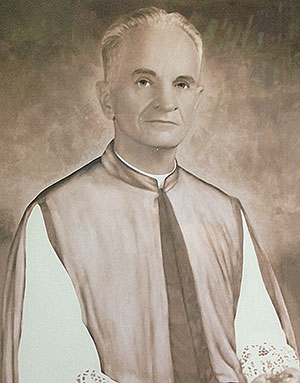Seeded in faith
Pioneering Guettler family shared success with church

BY PATTIE DURHAM
On acres of land along Delaware Avenue where cows once grazed and roosters crowed, now stands the bastion of Catholicism in St. Lucie County: St. Anastasia Grade School, John Carroll High School and St. Anastasia Church, the first parish in St. Lucie County. All thanks to a generous act of faith by George F. and Christine Guettler.
The development of the property began with a chance visit by two young brothers to the sunny shores of Florida, which in turn led to the migration of an extensive German Catholic immigrant family from snowy Minnesota. When George and Leo Guettler traveled from Cologne, Minnesota, to Melbourne, Florida, little did they know that their fates and that of their siblings would be so greatly altered.

Born into a German immigrant community in Cologne, the young men were educated in Minnesota, steeped in a deep and abiding Catholic faith. They had attended Catholic schools in Minnesota and went to work for a parish priest in the Melbourne area after their arrival. As there were no restaurants at that time, one of the Catholic families agreed to let the brothers eat their meals with them while they worked on land the parish priest owned. When the two returned to Cologne, George began corresponding with Christine Knecht, one of the daughters in the family that had fed them, who had graduated from high school and was teaching school in the Melbourne area.
After a year of correspondence, George and Leo made their way south again and George married Christine at St. Joseph’s Catholic Church in Palm Bay in 1923. The couple and Leo moved south to Fort Pierce and George bought the Peerless Ice Cream Company, located then on North Seventh Street, just north of Orange Avenue. Working in the ice cream factory, George’s workday started at 4:30 a.m., while Christine worked in the ice cream parlor from noon until 10 p.m. Their first child, Mary Elizabeth, was born in 1924, the first of many, many Guettler children to be born in St. Lucie County.
Leo had also been working at the ice cream company, which delivered the sweet treat to neighboring counties. A short time later, George and Leo’s parents, Edward and Elizabeth Guettler, left the family’s flour mill in Minnesota and moved to Fort Pierce along with seven of their 10 children. George’s father and brothers, Frank and Vincent, joined him in work at the ice cream factory and with deliveries.

Eventually, George left Peerless and bought land on the western edge of the city to begin farming. He raised cattle and chickens on land that stretched along South 33rd Street west to Hartman Road. On their arrival in Fort Pierce the family had moved into a home on South 13th Street and were soon surrounded by other Guettler families, but decided to build a larger home on Hartman Road in the 1930s.
Daughter Mary Elizabeth was followed by Norbert, George Edward, Cecilia, Mercedes, JoAnn Theresa, Christina Maria (an infant who died the day of her birth) and Joseph, the only child to be born in the farmhouse on Hartman Road, where he still lives to this day and where he and his late wife, Ann, raised 14 children.
In the 1950s, the bishop of the St. Augustine Diocese approached St. Anastasia parishioner George F. Guettler about purchasing land for a larger Catholic school as the old school at Tenth Street and Orange Avenue was burgeoning with students in the 12 grades it housed.
Working with his pastor, the Right Rev. Monsignor Michael Beerhalter, George agreed to sell some of the easternmost acreage to the diocese. Mary Elizabeth, George E. and Joseph Guettler recently shared that the diocese had been making payments on the sale of the land, but that the payments were transferred to Beerhalter to help build the new school.
“Daddy always gets credit for this,” Joe Guettler says, “but Mama and Daddy were one unit and sold the property to the diocese together. When the payments came in, they turned them over to Monsignor.”
In 1960, the new St. Anastasia School was dedicated. Grades 1-8 filled the classrooms of the new school, built with a large auditorium on its western end. The high school classes continued to be held at the old school building on Orange Avenue, and the name was changed to Central Catholic High School. Later, Beerhalter managed to build a high school on the former Guettler property. John Carroll Catholic High School was opened in the fall of 1965, graduating its first class of students in May 1966. The old school fell out of use.
In 1977, a new St. Anastasia Catholic Church was built near the elementary school, along with a rectory for the parish priests. The old church on Orange Avenue was a wooden structure that became too small for the growing number of Catholics moving to Fort Pierce. Eventually it became infested with termites and had to be torn down. While waiting to raise the funds for a new church, the parishioners attended Mass in the school auditorium on 33rd Street.
Family members say that the church officials came back seeking extra acreage, which was used for the high school football field and the soccer field. Houses occupied by George F. Guettler’s children and other Guettler cousins dot the Delaware Avenue corridor from John Carroll to Hartman Road.
Before the family moved to the farm, they lived in a house on South 13th Street, which at that time must have been close to the edge of Fort Pierce’s residential district. Other Guettler relatives who had migrated down from Minnesota also lived on the street.
George E. Guettler, 95, recalls some of the early life on 13th Street, remembering a time when he and his brother, Norbert, were playing with matches near hayfields owned by Phillip Hoeffner, who had married his aunt, Marie Guettler, and lived on 13th Street. The two little boys started a fire.
“We were upset and were trying to put the fire out,” George says, “when a black Ford coupe drove up and two guys got out. I don’t know if they were firemen or policemen, but they got some burlap sacks they wetted down and slapped the fire out. We still got in trouble for the matches.”

George says when he was 5 years old he drove the tractor for his father as he fertilized groves the family owned off McCarty Road, west of Fort Pierce. “He would walk and fill a bucket with fertilizer from the back of the tractor and fertilize the trees. I would drive it very slowly as he worked.”
The Guettler family was devoted to their church. The children attended St. Anastasia Catholic School and practiced their faith daily.
“We prayed the rosary together every night,” says Mary Elizabeth Noelke, at 98 the oldest of George F. and Christine’s children. “Every Saturday, we got clean ribbons for our scapulars.”
Whenever they weren’t in school, the boys in the family would go to work with their father in the groves. On their way to the groves, their father would stop to talk to Beerhalter’s brother, who lived on Okeechobee Road, and to Joseph Archambeault, a fellow grower.
During his travels, Archambeault, a French Canadian emigree, had gotten some navel orange grafts from South America, according to George.
“Dad got some of the grafts from his trees,” he says. “We planted seven acres of navels. Those (Archambeault’s) were the first navels in St. Lucie County.”
Through the years, George F. Guettler purchased groves off Trowbridge Road and a 20-acre grove on Kirby Loop Road that had belonged to his brother, Leo, and others. “After Daddy got it,” George says, “we planted about a fourth with tangerine trees, the rest was already valencias.”

Talking about their father’s mechanical aptitude, George remembers when he bought a Model T car and took it apart. He bought a kit of iron wheels and made a tractor from the car and the kit. This was the first tractor their father had. It ran on kerosene and had pockets on the fenders to hold tools.
“Norbert and I would ride in the pockets as Daddy worked in the groves,” George said.
At one point, their father went to buy a used tractor from his sister’s husband, Phillip Hoeffner, but the tractor had no reverse gear. “Mr. Hoeffner said: Good farmers don’t need to back up,” George says, with a chuckle.
The sons remembered their father buying 500 bales of tobacco to use for fertilizer. It came to Fort Pierce in a railcar and they say their Dad and others unloaded the tobacco, which was stored at the Backus boat yard by South Bridge. Eventually the tobacco was chopped up and used as fertilizer, spreading it behind the tractor using an apparatus created with the propeller from an airplane. They say their Dad bought a new Jeep engine and hooked it up to the propeller, using it to spray pesticides on the trees in the groves.
Not one to let his children sit idle, their father bought an old abandoned two-story house on Midway Road. He and his brothers took the house apart board by board with the aim of rebuilding it on the Guettler property.
“Norbert and I spent the summer pulling all of the nails from the boards,” George says. “Then they used the wood to build a two-story house on Delaware for my grandparents.
“My grandfather offered me 50 cents to straighten out a 5-gallon bucket of the nails,” he adds.
Remarking that it must have been built with excellent wood, the siblings add that the house was torn down years later and the wood was sold.
When the old St. Anastasia Catholic Church on Orange Avenue was torn down, George and others took the altar apart. A beautiful old altar, it was eventually taken to Melbourne and put back together in a church. The old church had quite an elaborate interior. The siblings said their mother was very artistic and made the stencils used to paint the ceiling. The bell from the church’s tower was taken down and now is used at St. Anastasia School.
During the 1950s, George F. Guettler and his sons, George, Norbert and Joseph, along with the boys’ grandfather, Edward, worked 300 acres of groves, running picking crews and maintaining the groves.
“One time, Dad took us about 10 miles west of Fort Pierce to dig up fence posts and load them on a truck,” George says. “On the way, we discovered that we had forgotten our water, but Dad refused to turn around and go back to the house. He dropped us off out there. It was hot. We had our lunch, but nothing to drink. I even went and looked at the water in the ditch, but I knew better. We kept digging. We sure were thirsty though.”
Joseph, known as Joe, lives in the home his parents built at the corner of Hartman Road and Delaware Avenue. His father sold other parcels of land, but had a small orange grove there, plus others in the county, which Joe worked.
Joanna Taylor, his oldest daughter, remembers a summer that she and her brothers picked oranges in the groves. Their father promised them bicycles for the effort. “That Christmas when we got up, we each had a brand-new 10-speed bicycle,” she says.
“That was a lot of work for me that Christmas putting all of those bicycles together,” Joe quipped.
Hard work and adherence to their Catholic faith have been Guettler family staples. Although many of the Guettlers were involved in agriculture, others branched off into other fields such as the building trades, land-clearing, air-conditioning and law. There are nearly 500 Guettler descendants in St. Lucie County today.
Two of Joe’s sons, Jeff and Conrad Guettler, and a granddaughter, Joanna, all work for St. Anastasia parish and schools, keeping everything as their grandfather and great-grandfather envisioned in his talks with his pastor, Beerhalter.
The program for the 100-year anniversary of St. Anastasia Parish contained a congratulatory note from the Most Rev. Gerald Barbarito, current Bishop of the Palm Beach Diocese, with a paragraph that appears to be a pointed reference to the tremendous gift of faith of George F. and Christine Guettler:
“Loved ones who have gone before us marked with the sign of faith, the very living stones that built St. Anastasia’s, continue to remind us to be faithful and generous in our daily lives.”
